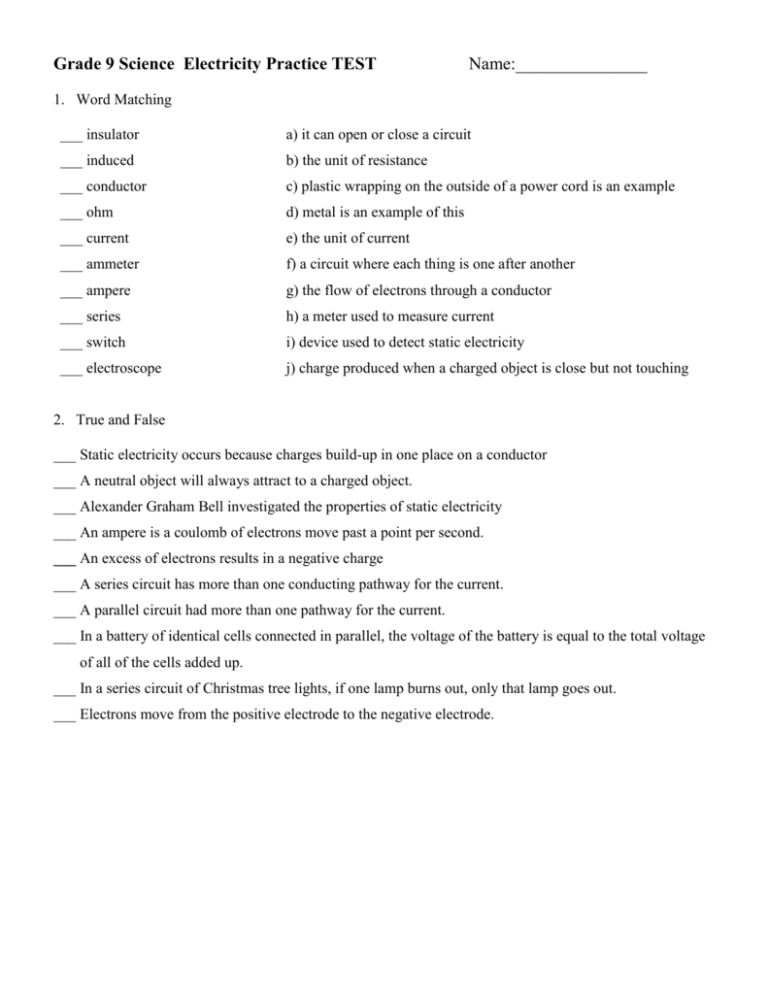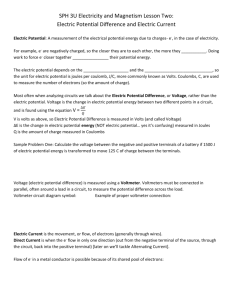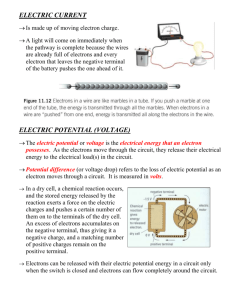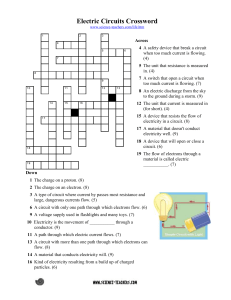Grade 9 Science Electricity Test Activity 1-7
advertisement

Grade 9 Science Electricity Practice TEST Name:_______________ 1. Word Matching ___ insulator a) it can open or close a circuit ___ induced b) the unit of resistance ___ conductor c) plastic wrapping on the outside of a power cord is an example ___ ohm d) metal is an example of this ___ current e) the unit of current ___ ammeter f) a circuit where each thing is one after another ___ ampere g) the flow of electrons through a conductor ___ series h) a meter used to measure current ___ switch i) device used to detect static electricity ___ electroscope j) charge produced when a charged object is close but not touching 2. True and False ___ Static electricity occurs because charges build-up in one place on a conductor ___ A neutral object will always attract to a charged object. ___ Alexander Graham Bell investigated the properties of static electricity ___ An ampere is a coulomb of electrons move past a point per second. ___ An excess of electrons results in a negative charge ___ A series circuit has more than one conducting pathway for the current. ___ A parallel circuit had more than one pathway for the current. ___ In a battery of identical cells connected in parallel, the voltage of the battery is equal to the total voltage of all of the cells added up. ___ In a series circuit of Christmas tree lights, if one lamp burns out, only that lamp goes out. ___ Electrons move from the positive electrode to the negative electrode. 3. The following true and false questions are about the circuit to the left: BELL ___ There are no switches in this circuit ___ The three lightbulbs are in parallel ___ The voltmeter is in series with the three lightbulbs ___ The light bulbs would be lit and the buzzer would be ringing ___ A meter for measuring the potential difference is attached ___ If you removed the bell, the lights would go out. ___ There are two cells in this schematic diagram. V 4. Draw a piece of Kleenex (tissue) attached to a balloon. Add charges to show why the Kleenex is stuck to the balloon. (2 points) 5. A portable CD player needs only 0.25 A of current. If the CD player is powered by a 9 V battery what is the resistance in the current? 6. A clothes dryer in your home is attached to a 220 V source. The heating elements have a 12 Ω. What is the current in the heating coils of the dryer? 7. What is the resistance (in Ω) of a 1500 W dryer plugged into a 110 V outlet, if the dryer has a 10 A current flowing through it. 8. What is the difference between an insulator and a conductor? Give two examples of each. 9. Explain clearly why a balloon rubbed with fabric will produce static electricity but a metal bar rubbed with fabric will not. Include the words charges moving freely, charges building up in one place, insulator, conductor in your explanation. 10. Draw the diagram that was used to explain induction. Add descriptions in your own words to make it clearer. 11. If there is a current of 15 amperes in a circuit and 3-(1.5v) cells connected in series. What will the resistance be in this circuit? 12. A buzzer plugged into a 110V wall socket has a resistance of 1.25 x 102 Ω. What is the resistance in the buzzer? 13. Draw a circuit that has a bulb attached in series to a 1.5 V cell, an ammeter and a switch. Find the resistance of the bulb if the switch is closed and the ammeter reads 0.0012 A. 14. Three resistors, with a total resistance of 20 ohms, are attached in parallel. There is a cell and an ammeter. (a) Draw the circuit. (b) If the cell offers 6 V of potential difference what is the current on the ammeter? 15. Draw a circuit showing two cells in (parallel) connected to three light bulbs, a switch and an ammeter in series. Indicate the direction of electron flow in the circuit. 16. You have set up 1000 christmas lights. They are plugged in and you discover that 5 of the lights are not working. (a) Are the lights connected in series or parallel? (b) Explain how you know the answer to 15a? 17. If a battery consists of four 1.5 V cells connected in series, what is its total voltage? A. 1.5 V B. 3.0 V C. 6.0 V D. 9 V 18. When you measure electric current, you measure A. how fast the electrons move in a wire B. how much energy the electrons have as they move through a wire C. how many electrons there are in a wire D. how many electrons pass a point in a wire in one second 19. When three cells are connected in parallel, the voltage f the combination is A. twice the voltage of a single cell B. three times the voltage of a single cell C. third the voltage of a single cell D. the same as a single cell 20. Which of the following obeys “Ohm’s Law”? A. V P R B. R V I C. I R V D. P V R







